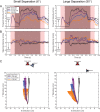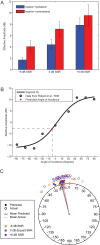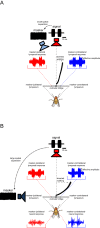How spatial release from masking may fail to function in a highly directional auditory system
- PMID: 28425912
- PMCID: PMC5443663
- DOI: 10.7554/eLife.20731
How spatial release from masking may fail to function in a highly directional auditory system
Abstract
Spatial release from masking (SRM) occurs when spatial separation between a signal and masker decreases masked thresholds. The mechanically-coupled ears of Ormia ochracea are specialized for hyperacute directional hearing, but the possible role of SRM, or whether such specializations exhibit limitations for sound source segregation, is unknown. We recorded phonotaxis to a cricket song masked by band-limited noise. With a masker, response thresholds increased and localization was diverted away from the signal and masker. Increased separation from 6° to 90° did not decrease response thresholds or improve localization accuracy, thus SRM does not operate in this range of spatial separations. Tympanal vibrations and auditory nerve responses reveal that localization errors were consistent with changes in peripheral coding of signal location and flies localized towards the ear with better signal detection. Our results demonstrate that, in a mechanically coupled auditory system, specialization for directional hearing does not contribute to source segregation.
Keywords: Ormia ochracea; cocktail-party-problem; mechanically coupled pressure receiver; neuroscience; song recognition; sound localization; spatial release from masking.
Conflict of interest statement
The authors declare that no competing interests exist.
Figures









Similar articles
-
Directional hearing by mechanical coupling in the parasitoid fly Ormia ochracea.J Comp Physiol A. 1996;179(1):29-44. doi: 10.1007/BF00193432. J Comp Physiol A. 1996. PMID: 8965258
-
A precedence effect resolves phantom sound source illusions in the parasitoid fly Ormia ochracea.Proc Natl Acad Sci U S A. 2009 Apr 14;106(15):6357-62. doi: 10.1073/pnas.0809886106. Epub 2009 Mar 30. Proc Natl Acad Sci U S A. 2009. PMID: 19332794 Free PMC article.
-
Inherent Directionality Determines Spatial Release from Masking at the Tympanum in a Vertebrate with Internally Coupled Ears.J Assoc Res Otolaryngol. 2016 Aug;17(4):259-70. doi: 10.1007/s10162-016-0568-6. Epub 2016 Apr 28. J Assoc Res Otolaryngol. 2016. PMID: 27125545 Free PMC article.
-
Parasitoid flies exploiting acoustic communication of insects-comparative aspects of independent functional adaptations.J Comp Physiol A Neuroethol Sens Neural Behav Physiol. 2015 Jan;201(1):123-32. doi: 10.1007/s00359-014-0958-3. Epub 2014 Nov 5. J Comp Physiol A Neuroethol Sens Neural Behav Physiol. 2015. PMID: 25369901 Review.
-
Enhancing Auditory Selective Attention Using a Visually Guided Hearing Aid.J Speech Lang Hear Res. 2017 Oct 17;60(10):3027-3038. doi: 10.1044/2017_JSLHR-H-17-0071. J Speech Lang Hear Res. 2017. PMID: 29049603 Free PMC article. Review.
Cited by
-
Parasitoid-host eavesdropping reveals temperature coupling of preferences to communication signals without genetic coupling.Proc Biol Sci. 2023 Aug 30;290(2005):20230775. doi: 10.1098/rspb.2023.0775. Epub 2023 Aug 16. Proc Biol Sci. 2023. PMID: 37583323 Free PMC article.
-
Spatial release from masking in crocodilians.Commun Biol. 2022 Aug 25;5(1):869. doi: 10.1038/s42003-022-03799-7. Commun Biol. 2022. PMID: 36008592 Free PMC article.
References
-
- Adamo SA, Robert D, Hoy RR. Effects of a tachinid parasitoid, Ormia ochracea, on the behaviour and reproduction of its male and female field cricket hosts (Gryllus spp) Journal of Insect Physiology. 1995;41:269–277. doi: 10.1016/0022-1910(94)00095-X. - DOI
-
- Allen GR, Kamien D, Berry O, Byrne P, Hunt J. Larviposition, host cues, and planidial behavior in the sound-locating parasitoid fly homotrixa alleni (Diptera: tachinidae) Journal of Insect Behavior. 1999;12:67–79. doi: 10.1023/A:1020929231430. - DOI
-
- Allen GR. The biology of the phonotactic parasitoid, Homotrixa sp. (Diptera: tachinidae), and its impact on the survival of male Sciarasaga quadrata (Orthoptera: tettigoniidae) in the field. Ecological Entomology. 1995;20:103–110. doi: 10.1111/j.1365-2311.1995.tb00435.x. - DOI
-
- Bauer R, Zhang Y, Jackson JC, Whitmer WM, Brimijoin WO, Akeroyd M, Uttamchandani D, Windmill JFC. Housing influence on multi-band directional MEMS microphones inspired by Ormia ochracea. IEEE Sensors; Orlando, United States: Institute of Electrical and Electronics Engineers; 2016. - DOI
Publication types
MeSH terms
LinkOut - more resources
Full Text Sources
Other Literature Sources

